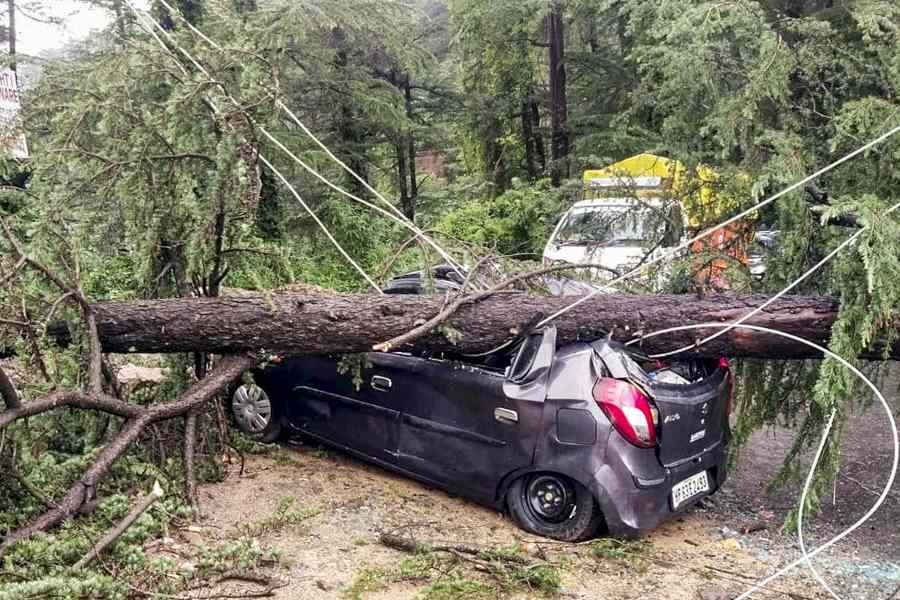 |
| Midsummer sunrise at Stonehenge. Picture by Samhita Chakraborty Lahiri |
My relationship with the Stonehenge started seven years ago, from the day my father surprised me with a laptop. Giddy with excitement, I had switched it on to find the Stonehenge etched on the screen — one of the many default Microsoft wallpapers, but to me, the gateway to a whole new world.
So when I found myself living in the south of England for a while, I knew I had to go to the stones. I ended up going at the Unesco World Heritage Site on the most special day, the Summer Solstice Festival on June 21.
The day is special in more ways than one — it is one of the rare occasions when visitors are allowed inside the stone circle. On other days, the ancient monument can be admired only from a distance, having been cordoned off since 1978 for its protection.
But the day was not just about getting up close and personal with the stones. There was the summer solstice sunrise too, marking the beginning of the longest day of the northern hemisphere.
This is the one time in the year when the Heel Stone, an odd-shaped stone just outside the circle proper, aligns with the rising sun.
The phenomenon is said to have a myriad astronomical, religious and ritualistic significance. For others, it’s an occasion to party away the night in the open meadows surrounding the stones, under an inky sky decorated with thousands of stars.
This year, 20,000 people stayed up all night to welcome the midsummer sun. The journey began the previous evening (June 20) at Salisbury, a quaint little town in Wiltshire county, which has a cathedral with the tallest spire in all of England. Special buses painted with the Stonehenge motif took visitors from the Salisbury rail and bus stations to a spot near the stones, from where we had to walk through undulating green fields for a little over a mile.
One could also drive down instead of taking the bus, but visitors were encouraged to avail themselves of public transport to minimise the carbon footprint of the festival. Entry to the pre-historic site is free for the festival though the bus charges a small fare.
I reached the stones around 10.30pm when the party was just getting started. I wove my way through the crowd that was swelling by the minute and entered the circle. I touched one of the stones, the surface was rough and partly covered with dried lichen.
I had assumed that millennia of weathering would have rendered them as smooth as marble. The stones were warm to the touch, possibly because it had been a bright sunny day. Many were hugging the stones, caressing them, whispering to them. That’s how much they love their monument.
I started walking around the stones, pondering on the mystery behind how they got here. It’s strange that we still don’t know exactly who built the Stonehenge or why. More importantly, how in god’s name did they carry those massive stones from afar?
 |
| ● The Stonehenge is believed to have been built in three phases between 3000 BC and 1600 BC ● The circle was aligned with the midsummer sunrise, the midwinter sunset, and the most southerly rising and northerly setting of the moon. ● There were two types of stones used: the “bluestones” (weighing as much as four tonnes and brought from over 380km away) and the Sarsen stones (averaging 18ft in height and 25 tonne in weight). ● In total, Stonehenge is made up of more than 1,500 tonnes of rock. It has been estimated that the construction of Stonehenge required more than 30 million hours of labour. ● Experts believe the Stonehenge was simultaneously used for astronomical observation and ritual functions, including burials. ● The Stonehenge is one of Britain’s most popular tourist spots with over 850,000 visitors a year. ● It is situated 137km west of London in the Salisbury Plains in Wiltshire county. ● The midsummer sunrise began attracting visitors in the 1870s. |
I overheard one girl telling another that she believed that God had made the Stonehenge, her friend replied that it was possibly the handiwork of giants. “Or maybe really good engineers,” I chipped in… we all laughed and wished each other “Happy Solstice”.
I started ambling around the greens, a cup of steaming coffee in hand. There were drumbeats everywhere, coupled with bongos, guitars and trumpets that made as much of a racket as the vuvuzela.
People broke into impromptu jigs ever so often, some showed off juggling skills, some gyrated with hoola hoops. Many just sat on the soft green grass, out on a midnight picnic. The sheer magic of the moment, the celebration of the here and the now reminded me of Maddox Square on Ashtami night, only manifold.
The sight of rum mixed with cola in plastic bottles and the whiff of weed helped jog my memory. Small amounts of alcohol are permitted at the festival, though I’m sure not the dope.
A little away from the stones stood a massive 20ft steel structure sculpted after the image of man, titled the Ancestor, with arms raised to welcome the sun.
Ceremonies and performances by druids, neo-pagans, new-agers and other believers in elaborate costumes kept me enthralled till the wee hours, till I realised that my limbs were freezing and my internal organs shutting off one by one.
I made a beeline for one of the two coal ovens and thawed my insides. They should really have put up more such ovens!
The facilities were otherwise impeccable; the makeshift loos surprisingly clean even at 3 in the morning. There was a kiosk for drinking water and food stalls selling piping hot pizzas, burgers, pancakes and tea, coffee and hot chocolate.
Around 4am, the sky started clearing up, changing from black to navy to violet to blue with splashes of orange. The last few years, cloudy skies had robbed the visitors of the midsummer sunrise.
Faces looked tense, what would it be this year? Twenty thousand pairs of eyes trained on the eastern horizon, urging the sun to come out.
Someone said the scheduled sunrise was at 4.45, but that hour came and went, but not the sun. By 4.50, the day was getting brighter but the sun remained elusive.
Suddenly, at 4.52, brilliant golden rays punctured the cloud and burst out from behind the Stonehenge. Twenty thousand voices cheered in unison. I looked in wonder, my camera forgotten in my hands (though I regained my senses in a minute and clicked away fervently).
Drummers beat their drums with renewed vigour, trumpets rent the air and people danced in joy. It was a perfect ending to a perfect night.











